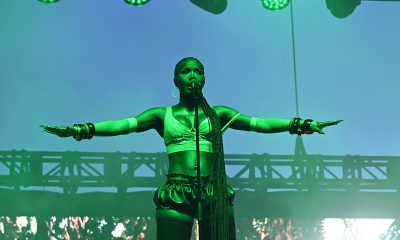Books
D.C. couple’s new book is spin-off of popular LGBT Instagram page
Project took on a life of its own since launching two-and-a-half years ago
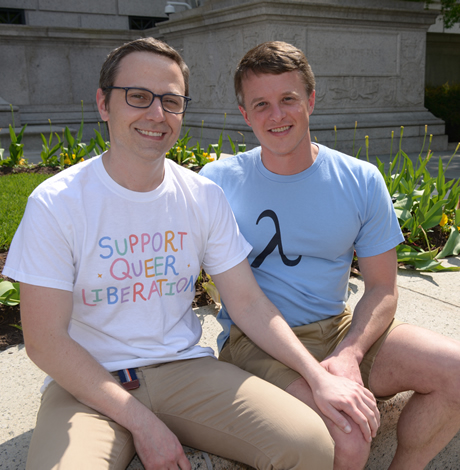
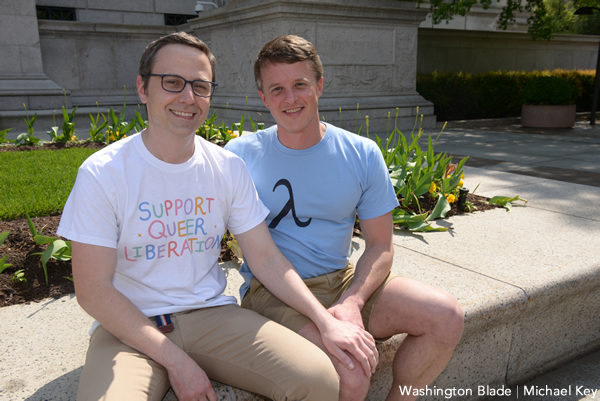
Matthew Riemer is shocked how many people think the Stonewall Riots were the beginning of the LGBT liberation movement.
“We are teaching kids from the get-go that their history started in 1969. It’s ridiculous,” Riemer says. “As queer people, we’re this group who have been denied our history.”
He and his partner Leighton Brown, both attorneys and Washington residents, run the popular @lgbt_history Instagram account and are now coming out with a book on the history of LGBT activism. “We Are Everywhere: Protest, Power and Pride in the History of Queer Liberation” (Ten Speed Press) will be released on Tuesday, May 7 and its two authors sat down with the Blade for an interview. They’ll be at Solid State Books (600 H St., N.E.) on Wednesday, May 8. It’s free and starts at 7 p.m.
The men created the account as a personal project after realizing they didn’t know much about their own history themselves.
Riemer does the text-based research and Brown finds photos for the account.
“We were just on a personal quest to learn, and we had gotten a little bit obsessive about it,” Brown says.
“A little bit obsessive” probably doesn’t do justice to the account or the research the two men have conducted.
Brown and Riemer first posted on Jan. 17, 2016. Just over three years later, they have nearly 5,000 posts and about 380,000 followers.
Each post is an image of an event in LGBT history or simply a historical photograph of LGBT people. These photos are accompanied by anywhere from a few lines to multiple paragraphs of descriptive text.
Recent posts include a picture of the “How Gay is Gay” cover from TIME in 1979. Under it is a description of the article, which discussed the rise of gays and lesbians choosing to live openly.
Another features an image of trans activist Marsha P. Johnson in Hoboken, N.J., on Easter Sunday.
Both men say the account has seen gradual growth to where it is today.
“It’s been just steady progress,” Brown says, while also noting that Laverne Cox regrammed a couple of their photos in the early stages.
Riemer wants to emphasize that the account is more than just another social media page. It’s become a well-research archive for LGBT history.
“We hope we are taken seriously and we believe we deserve to be taken seriously,” Riemer says. “We don’t write anything that can’t be backed up with primary, or at least secondary, sources.”
They cite those sources, too.
“We’ve been very serious about crediting and, when it’s possible, tagging photographers, archivists and activists or whoever is in the picture,” Riemer says.
Brown and Riemer love the platform Instagram provides them. But they also realize it comes with restrictions.
“The account is limiting not only in that it’s 2,200 characters but also in that queer history is really all connected,” Riemer says. “We weren’t able to show that on the account. There’s no hyperlinking. We don’t know if people are reading the captions. And we don’t know when people started following.”
That’s how the idea of a book emerged. “We Are Everywhere” comes out in a few days, just in time for the 50th anniversary of the Stonewall riots.
But its content stretches back long before Stonewall and details LGBT history up until the early 2000s in a near-chronological manner. Chapters include large glossy images, curated by Brown, and accompanying narrative, written by Riemer.
And it doesn’t focus on the events one might expect to see.
“You don’t read that much about gays in the military or gay marriage,” Riemer says of the book. “We want to talk about queer history, our history, not our story of how we related to the straight people.”
Reimer remembers that when he first came out as gay, he “tried to be the straight-gay.” “A lot of us did that and still do, especially gay, cis white men,” he says.
His research into LGBT history changed his mind on how he had to act and who he had to be.
“We don’t fit into the broader society,” Brown says. “And that’s great,” Riemer chimes in.
“The book isn’t just about a few moments where we have had some clear advancement with respect to the larger society,” Brown says. “It’s about all the good and bad that got us to that advancement and the setbacks in between.”
And it took hours of archival research to put the book together. Riemer left his job as an attorney to work on the book full time when he and Brown signed the deal with Ten Speed Press.
He started writing the text over a year ago and visited more than 10 archives across the country as well as a bunch more online to weave the book together.
“We just wanted to get it right, and it’s been absolutely exhausting,” Riemer says.
The book has already received praise from giants within the LGBT community.
Anderson Cooper, who also follows the @LGBT_History Instagram account, wrote: “Our history hasn’t been taught in schools; it’s been passed from person to person, whispered through the ages, often in the dark of night between lovers. But whisper no more. Here we are, in these pages — our pride and power, our blood and tears, our love and laughter. This is our fight, our history, and we must learn it.”
Now that the book is finished and its release is around the corner, Riemer and Brown are focusing on promoting it. They have events at college campuses across the country and in June, they’re slated to speak at the LGBT Center in New York.
“We Are Everywhere,” the two men hope, brings to life the stories of the radicals of the LGBT liberation movement.
“What we’ve found is it’s always been the craziest, the most outlandish, the loudest — the ones who the mainstreamers say, ‘We’re not all like that’ — those were the ones who create the space for the rest of us,” Riemer says.
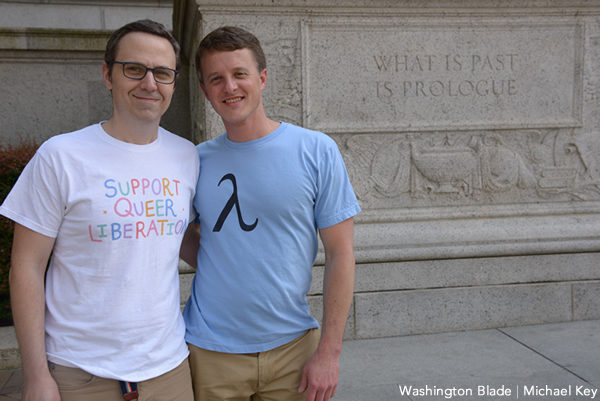
Books
Two new books on dining out LGBTQ-style
Visit nightclubs, hamburger joints, and a bathhouse that feeds customers

‘What is Queer Food? How We Served a Revolution’
By John Birdsall
c.2025, W.W. Norton
$29.99/304 pages
‘Dining Out: First Dates, Defiant Nights, and Last Call Disco Fries at America’s Gay Restaurants’
By Erik Piepenburg
c.2025, Grand Central
$30/352 pages
You thought a long time about who sits where.
Compatibility is key for a good dinner party, so place cards were the first consideration; you have at least one left-hander on your guest list, and you figured his comfort into your seating chart. You want the conversation to flow, which is music to your ears. And you did a good job but, as you’ll see with these two great books on dining LGBTQ-style, it’s sometimes not who sits where, but whose recipes were used.
When you first pick up “What is Queer Food?” by John Birdsall, you might miss the subtitle: “How We Served a Revolution.” It’s that second part that’s important.

Starting with a basic gay and lesbian history of America, Birdsall shows how influential and (in)famous 20th century queer folk set aside the cruelty and discrimination they received, in order to live their lives. They couldn’t speak about those things, he says, but they “sat down together” and they ate.
That suggested “a queer common purpose,” says Birdsall. “This is how who we are, dahling, This is how we feed our own. This is how we stay alive.”
Readers who love to cook, bake or entertain, collect cookbooks, or use a fork will want this book. Its stories are nicely served, they’re addicting, and they may send you in search of cookbooks you didn’t know existed.
Sometimes, though, you don’t want to be stuck in the kitchen, you want someone else to bring the grub. “Dining Out” by Erik Piepenburg is an often-nostalgic, lively look at LGBTQ-friendly places to grab a meal – both now and in the past.

In his introduction, Piepenburg admits that he’s a journalist, “not a historian or an academic,” which colors this book, but not negatively. Indeed, his journeys to “gay restaurants” – even his generous and wide-ranging definitions of the term – happily influence how he presents his narrative about eateries and other establishments that have fed protesters, nourished budding romances, and offered audacious inclusion.
Here, there are modern tales of drag lunches and lesbian-friendly automats that offered “cheap food” nearly a century ago. You’ll visit nightclubs, hamburger joints, and a bathhouse that feeds customers on holidays. Stepping back, you’ll read about AIDS activism at gay-friendly establishments, and mostly gay neighborhood watering holes. Go underground at a basement bar; keep tripping and meet proprietors, managers, customers and performers. Then take a peek into the future, as Piepenburg sees it.
The locales profiled in “Dining Out” may surprise you because of where they can be found; some of the hot-spots practically beg for a road trip.
After reading this book, you’ll feel welcome at any of them.
If these books don’t shed enough light on queer food, then head to your favorite bookstore or library and ask for help finding more. The booksellers and librarians there will put cookbooks and history books directly in your hands, and they’ll help you find more on the history and culture of the food you eat. Grab them and you’ll agree, they’re pretty tasty reads.
The Blade may receive commissions from qualifying purchases made via this post.

You’re going to be on your feet a lot this month.
Marching in parades, dancing in the streets, standing up for people in your community. But you’re also likely to have some time to rest and reflect – and with these great new books, to read.
First, dip into a biography with “Marsha: The Joy and Defiance of Marsha P. Johnson” by Tourmaline (Tiny Rep Books, $30), a nice look at an icon who, rumor has it, threw the brick that started a revolution. It’s a lively tale about Marsha P. Johnson, her life, her activism before Stonewall and afterward. Reading this interesting and highly researched history is a great way to spend some time during Pride month.
For the reader who can’t live without music, try “The Dad Rock That Made Me a Woman” by Niko Stratis (University of Texas Press, $27.95), the story of being trans, searching for your place in the world, and finding it in a certain comfortable genre of music. Also look for “The Lonely Veteran’s Guide to Companionship” by Bronson Lemer (University of Wisconsin Press, $19.95), a collection of essays that make up a memoir of this and that, of being queer, basic training, teaching overseas, influential books, and life.
If you still have room for one more memoir, try “Walk Like a Girl” by Prabal Gurung (Viking, $32.00). It’s the story of one queer boy’s childhood in India and Nepal, and the intolerance he experienced as a child, which caused him to dream of New York and the life he imagined there. As you can imagine, dreams and reality collided but nonetheless, Gurung stayed, persevered, and eventually became an award-winning fashion designer, highly sought by fashion icons and lovers of haute couture. This is an inspiring tale that you shouldn’t miss.
No Pride celebration is complete without a history book or two.
In “Trans History: From Ancient Times to the Present Day” by Alex L. Combs & Andrew Eakett ($24.99, Candlewick Press), you’ll see that being trans is something that’s as old as humanity. One nice part about this book: it’s in graphic novel form, so it’s lighter to read but still informative. Lastly, try “So Many Stars: An Oral History of Trans, Nonbinary, Genderqueer, and Two-Spirit People of Color” by Caro De Robertis (Algonquin Books of Chapel Hill. $32.00) a collection of thoughts, observations, and truths from over a dozen people who share their stories. As an “oral history,” you’ll be glad to know that each page is full of mini-segments you can dip into anywhere, read from cover to cover, double-back and read again. It’s that kind of book.
And if these six books aren’t enough, if they don’t quite fit what you crave now, be sure to ask your favorite bookseller or librarian for help. There are literally tens of thousands of books that are perfect for Pride month and beyond. They’ll be able to determine what you’re looking for, and they’ll put it directly in your hands. So stand up. March. And then sit and read.
a&e features
James Baldwin bio shows how much of his life is revealed in his work
‘A Love Story’ is first major book on acclaimed author’s life in 30 years

‘Baldwin: A Love Story’
By Nicholas Boggs
c.2025, FSG
$35/704 pages
“Baldwin: A Love Story” is a sympathetic biography, the first major one in 30 years, of acclaimed Black gay writer James Baldwin. Drawing on Baldwin’s fiction, essays, and letters, Nicolas Boggs, a white writer who rediscovered and co-edited a new edition of a long-lost Baldwin book, explores Baldwin’s life and work through focusing on his lovers, mentors, and inspirations.
The book begins with a quick look at Baldwin’s childhood in Harlem, and his difficult relationship with his religious, angry stepfather. Baldwin’s experience with Orilla Miller, a white teacher who encouraged the boy’s writing and took him to plays and movies, even against his father’s wishes, helped shape his life and tempered his feelings toward white people. When Baldwin later joined a church and became a child preacher, though, he felt conflicted between academic success and religious demands, even denouncing Miller at one point. In a fascinating late essay, Baldwin also described his teenage sexual relationship with a mobster, who showed him off in public.
Baldwin’s romantic life was complicated, as he preferred men who were not outwardly gay. Indeed, many would marry women and have children while also involved with Baldwin. Still, they would often remain friends and enabled Baldwin’s work. Lucien Happersberger, who met Baldwin while both were living in Paris, sent him to a Swiss village, where he wrote his first novel, “Go Tell It on the Mountain,” as well as an essay, “Stranger in the Village,” about the oddness of being the first Black person many villagers had ever seen. Baldwin met Turkish actor Engin Cezzar in New York at the Actors’ Studio; Baldwin later spent time in Istanbul with Cezzar and his wife, finishing “Another Country” and directing a controversial play about Turkish prisoners that depicted sexuality and gender.
Baldwin collaborated with French artist Yoran Cazac on a children’s book, which later vanished. Boggs writes of his excitement about coming across this book while a student at Yale and how he later interviewed Cazac and his wife while also republishing the book. Baldwin also had many tumultuous sexual relationships with young men whom he tried to mentor and shape, most of which led to drama and despair.
The book carefully examines Baldwin’s development as a writer. “Go Tell It on the Mountain” draws heavily on his early life, giving subtle signs of the main character John’s sexuality, while “Giovanni’s Room” bravely and openly shows a homosexual relationship, highly controversial at the time. “If Beale Street Could Talk” features a woman as its main character and narrator, the first time Baldwin wrote fully through a woman’s perspective. His essays feel deeply personal, even if they do not reveal everything; Lucian is the unnamed visiting friend in one who the police briefly detained along with Baldwin. He found New York too distracting to write, spending his time there with friends and family or on business. He was close friends with modernist painter Beauford Delaney, also gay, who helped Baldwin see that a Black man could thrive as an artist. Delaney would later move to France, staying near Baldwin’s home.
An epilogue has Boggs writing about encountering Baldwin’s work as one of the few white students in a majority-Black school. It helpfully reminds us that Baldwin connects to all who feel different, no matter their race, sexuality, gender, or class. A well-written, easy-flowing biography, with many excerpts from Baldwin’s writing, it shows how much of his life is revealed in his work. Let’s hope it encourages reading the work, either again or for the first time.
-

 U.S. Supreme Court4 days ago
U.S. Supreme Court4 days agoSupreme Court upholds ACA rule that makes PrEP, other preventative care free
-

 U.S. Supreme Court4 days ago
U.S. Supreme Court4 days agoSupreme Court rules parents must have option to opt children out of LGBTQ-specific lessons
-
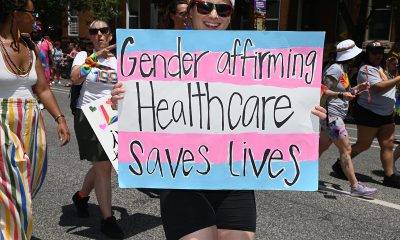
 Congress5 days ago
Congress5 days agoSenate parliamentarian orders removal of gender-affirming care ban from GOP reconciliation bill
-
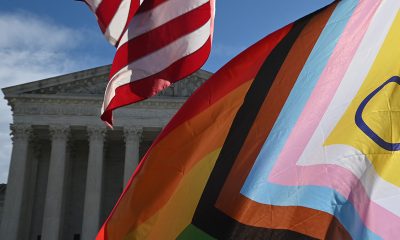
 Opinions5 days ago
Opinions5 days agoMy heart goes out to trans community and their families

